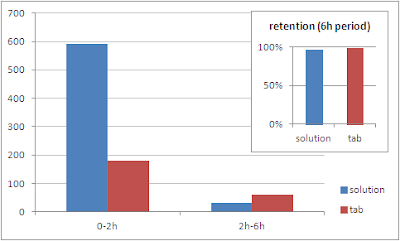 |
| Image 1: Tabbing or cabbing, or just washing it down with some water - what is the best way to take your beta alanine? |
The more it tingles the less it works... !?
Despite the fact that I personally like the awkward feeling you get when you take tons of beta alanine, I have always suspected that the "tingling" sensation - whatever its underlying reasons may be - is a very unsatisfactory indicator of whether the supplement "works" or not. After all, there is no physiological reason why the intended recombination of beta alanine + histidine to carnosine and the storage of the latter inside of your muscle tissues would go hand in hand with a "pins and needles" kind of flush. I was thus not surprised to see that Jacques Décombaz and his collegues from the Nestlé Research Center in Lausanne, Switzerland were able to show that ingestion of a "time-released" beta alanine tablet (2x800mg) did not only lead to statistically significant reductions in paraesthesia, but did also reduce the urinary excretion of the carnosine precursor (Décombaz. 2011).
 |
| Figure 1: Beta alanine (BA) serum values in µmol/L in the 6h after ingestion of 1.6 g of BA in solution or as time-released tablet (2x800mg); small graph: area under the curve (data based on Décombaz. 2011) |
 |
| Figure 2: Urinary beta alanine excretion (in µmol) in 11 healthy volunteers 0-2h and 2-6h after ingestion of 1.6 g of BA in solution or as time-released tablet (2x800mg); small graph: degree of retention (in % of intake) calculated based on urinary excretion (data based on Décombaz. 2011) |
 |
| Figure 3: Topography of b-alanine-induced sensations. Data shown are the maximal reported values of the body surface sensitive score (directly from Décombaz. 2011) |
... and why does it tingle? We still don't know!
What I personally do yet find more interesting than the reductions in sensory "side effects" are the speculations the scientists make as far as the underlying physiological reasons for the occurrence of the "pins and needles" (this was the prevailing description of the symptoms the study participants used) are concerned:
There are at least five recognized receptor sites for bA and the mechanism responsible for the sensitization of nociceptive neurons has not been unequivocally clarified [...] candidates include (a) bA-activated strychnine-sensitive glycine receptor sites, in association with glutamate sensitive N-methyl-D-aspartate receptors in the brain and the central nervous system, and (b) the mas-related gene family of G protein-coupled receptors, in dorsal root ganglia neurons ending in the skin, which are triggered by interactions with specific ligands such as bA.While option b) sounds relatively harmless, option a) and previous studies reporting profound modulatory effects on brain neurotransmitter levels (esp. serotonin, cf. Murakami. 2010) keep me wondering, if beta alanine does not have more (and potentially harmful) side-effects than the minor paraesthesia.
So, in essence, we still don't know what it is that causes this feeling some people like, most people ignore and a handful of people hate so much that the time released tablets may in fact provide an adequate (yet obviously more expensive) alternative to powders or caps to max out their carnosine stores while avoiding the inconvenient sensation of "pins and needles" punctuation their flesh.
 |
| Image 2: Time released beta alanine in its natural form |
Update: Click here for the second part of this beta alanine double-whammy.